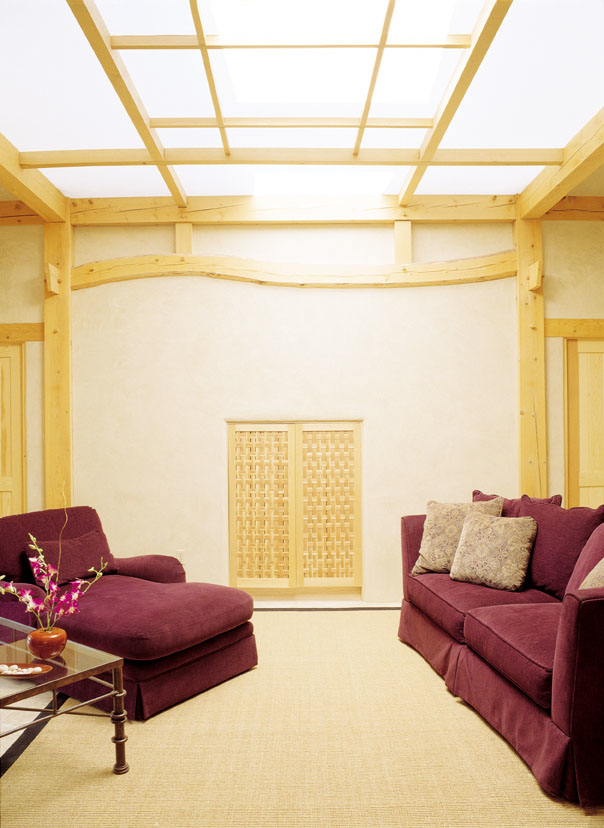On Wabi-Sabi Weekends, I post excerpts from my book, Simply Imperfect: Revisiting the Wabi-Sabi House.
“Grace fills empty spaces, but it can only enter where there is a void to receive it.”—Simone Weil
A couple years ago I gave a workshop called “Making Your Home Your Sanctuary” in New York City. Before we got under way, each of us talked about what we loved—and hated—about our homes. Almost every participant mentioned clutter as his or her number one obstacle to having a happy home. They knew it was messing with their serenity, but they felt powerless to do anything about it.
New Yorkers do live in smaller, more crowded spaces than most, but they’re not alone in their addiction to clutter. During a photo shoot in rural northern California several years ago, I met Linda, who had built herself a stunning straw-bale home, meticulously designed to give her abundant space and sunlight. A playwright and artist, Linda had asked her architect to include a large office and studio in the back of the house, but when we scouted it for possible shots, we couldn’t maneuver through the mess. Linda had set up her computer on an old desk that was falling apart. Shelves were littered with out-of-date phonebooks and files, and every corner was filled with boxes of assorted stuff. A beautiful heirloom table was shoved into the corner as a place to pile more clutter, and her sculpting table stuck out oddly in the middle of the room. We moved it all out of the way to stage a simple, nearly empty photograph in which the room’s graceful curves and clean light were the stars. “Oh, my gosh,” Linda sighed. “This is actually a really beautiful room. I never come in here, because it’s all so overwhelming. I’ve been wondering how I’ll ever finish my next play.”
I talked Linda into dumping the broken desk, and together we moved out all of the files and boxes. Linda pulled the antique table from its corner and set up a workspace looking out into the empty room. “There was just too much stuff,” she kept saying in amazement. “I’ve asked so many people how I could make this a nice room, and there was just too much stuff!” As she opened the antique table drawer for the first time since she’d moved in, she was delighted to find a collection of linen napkins she thought she’d lost.
You Can Unclutter
Uncluttering is common sense; there’s no magic to it. All the experts offer the same basic advice, in one form or another. It goes like this:
—Don’t try to unclutter your entire house at once. Start with a drawer or a shelf and move on to problem areas (such as the garage or the basement) once you’ve had some smaller success.
—Maintenance is key. Spend fifteen minutes per day cleaning up daily detritus before it becomes overwhelming.
—Take everything out of a drawer or closet and spread it out in front of you. You’ll eliminate more and organize what’s left more efficiently if you can see it all at once. (This also gives you a chance to clear out the dust and run a damp rag over the surface.)
—Mark four boxes or bags “Keep,” “Give Away,” “Throw Away,” and “Hold for One Year.” (The last one’s for items you don’t need or use but just can’t bear to part with yet. If you haven’t touched these things in a year, their time has come.)
—If in doubt, throw it out. Give it to Goodwill or any of the charitable organizations who send trucks around to collect it. Or give it away on Craig’s List. Nothing moves faster than the stuff in the “Free” listings.
—If you can’t find a good home for something, it’s time to say farewell.
—Get rid of two items every time you buy a new one.
—Keep like items with like: cups, baking goods, candles, etc.
—Allow only three items on each surface.
—Cover only about one-tenth of a table; use objects of differing sizes.
—Just say no to refrigerator magnets. They encourage clutter.
—Keep windowsills clear of knickknacks and potted plants.
—Keep clutter contained. Use baskets and bowls to collect mail, pens and pencils, loose change and all the other odds and ends that collect on counters and tabletops.
—Storage is key to containing clutter. Storage areas should make up at least ten percent of your home’s total square footage and be placed so that you can store items where they’re used. (If you can’t get rid of the stuff, hide it well.)
—Furnishings that do double duty as storage help minimize clutter. A wicker chest holding blankets can serve as a coffee table in the TV room; a small chest of drawers makes a great end table.
